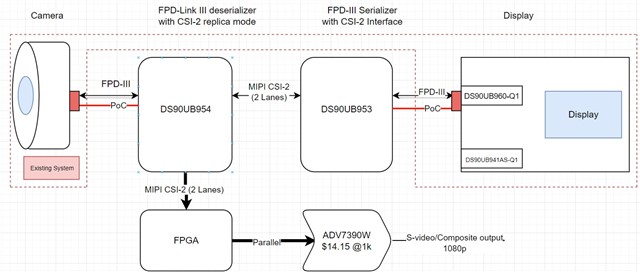Other Parts Discussed in Thread: DS90UB960-Q1, DS90UB953-Q1
Hello
Similar to previous posts, I need to split/break into an FPD-III link so that camera data can be displayed live and also recorded. I've tried to highlight the existing system in red.
From what I can gather, it should be possible to take the FPD-III from the camera and split it into two identical MIPI CSI-2 outputs, one of these feeds will be used by an FPGA for processing, the other will be reserialized and passed to the original system display. The display uses deserializer DS90UB960-Q1, but I can't currently get any information on what serializer is being used in the camera, as it's a potted assembly.
The video format is 1080p @30Hz.

So my questions are:
1 - Without knowing what device is serializing the camera data, is it possible to say if this system will work? I know in a lot of other threads there's been quite specific lists of compatible parts. The DS90UB960-Q1 states that it is compatible with the DS90UB953-Q1, so I think we're okay on that side of the link.
2 - Will the secondary control data (I2C), bridge the MIPI CSI-2 link?
3 - If the MIPI CSI-2 data to the FPGA has the control data embedded in it, is this going to cause issues for processing? From what I can gather, the bidirectional control data is proprietary to TI, so I'm not sure how it will be handled.
Thanks
Dan



